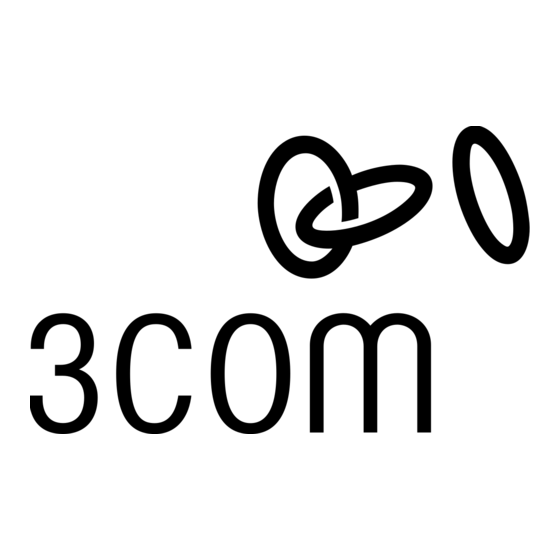3Com SuperStack 3 Baseline 3C16475 Benutzerhandbuch - Seite 2
Blättern Sie online oder laden Sie pdf Benutzerhandbuch für Schalter 3Com SuperStack 3 Baseline 3C16475 herunter. 3Com SuperStack 3 Baseline 3C16475 9 Seiten. 10/100 switch 24-port 10base-t/100base-tx plus 2-port 1000base-t

H
U
OW TO
1
13
6
The numbers in this diagram refer to numbered sections in the
text.
Front Panel
24 RJ-45 10/100 Ports and 2 RJ-45 1000 Ports
1
WARNING: RJ-45 Ports. These are shielded RJ-45 data
sockets. They cannot be used as standard traditional
telephone sockets, or to connect the unit to a traditional
PBX or public telephone network. Only connect RJ-45
data connectors, network telephony systems, or network
telephones to these sockets.
Either shielded or unshielded data cables with shielded or
unshielded jacks can be connected to these data sockets.
AVERTISSEMENT: Points d'accès RJ-45. Ceux-ci sont
protégés par des prises de données. Ils ne peuvent pas
être utilisés comme prises de téléphone conventionnelles
standard, ni pour la connection de l'unité à un réseau
téléphonique central privé ou public. Raccorder seulement
connecteurs de données RJ-45, systèmes de réseaux de
téléphonie ou téléphones de réseaux à ces prises.
Il est possible de raccorder des câbles protégés ou non
protégés avec des jacks protégés ou non protégés à ces
prises de données.
WARNHINWEIS: RJ-45-Porte. Diese Porte sind geschützte
Datensteckdosen. Sie dürfen weder wie normale
traditionelle Telefonsteckdosen noch für die Verbindung
der Einheit mit einem traditionellem privatem oder
öffentlichem Telefonnetzwerk gebraucht werden. Nur
RJ-45-Datenanscluße, Telefonnetzsysteme or Netztelefone
an diese Steckdosen anschließen.
Entweder geschützte oder ungeschützte Buchsen dürfen
an diese Datensteckdosen angeschlossen werden.
10BASE-T/100BASE-TX Ports
The Baseline 10/100 Switch has 24 10/100 Mbps auto-negotiating
ports. Each port supports automatic MDI/MDI-X detection and can
be connected to either a 10BASE-T or a 100BASE-TX device.
Ports 1 to 24 are auto-negotiating: their speed and duplex mode
(half duplex or full duplex) are automatically determined by the
capabilities of the connected device.
The Switch offers priority queuing, which means all packets that
are received are examined to see if they have been priority
encoded. If a packet has been, then the Switch will read the
priority level and determine whether the packet should be
directed through the normal or high priority channel. This feature
can be useful for example during excessive loads when one type
of traffic may require priority over another. The Switch is
configured to comply with 802.1p, VLAN tagged frames.
B
SE THE
ASELINE
1
4
5
8
9
16
17
20
21
10/100 S
WITCH
12
24
3
2
Traffic prioritization ensures that high priority data is forwarded
through the Switch without being delayed by lower priority data.
It differentiates traffic into classes and prioritizes those classes
automatically. Traffic prioritization uses the multiple traffic queues
that are present in the hardware of the Switch to ensure that
high priority traffic is forwarded on a different queue from lower
priority traffic, and is given preference over that traffic. This
ensures that time-sensitive traffic gets the highest level of service.
The 802.1D standard specifies eight distinct levels of priority (0 to
7), each of which relates to a particular type of traffic. The priority
levels and their traffic types are shown in the following table.
Priority Level
0
1
2
3
4
5
6
7
The traffic prioritization feature supported by the Switch
is compatible with the relevant sections of the IEEE
802.1D standard (incorporating IEEE 802.1p).
f you connect two Baseline 10/100 Switch units together,
I
the link between them operates at 100 Mbps full duplex.
You must use Category 5 cable when connecting the
units.
CAUTION: The Baseline 10/100 Switch supports full
!
duplex auto-negotiation. If the connected device does not
support auto-negotiation, the Switch will operate in half
duplex mode (even if the device is operating in full duplex
mode). In such a configuration, you may notice some
degradation of network performance. 3Com recommends
that you use devices that are capable of auto-negotiation
(and that you ensure that auto-negotiation is enabled, if
it is a configurable option).
2
24-P
4
5
Traffic Type
Best Effort
Background
Standard (spare)
Excellent Effort (business critical)
Controlled Load (streaming multimedia)
Video (Interactive media), less than 100 millisecondsn
latency and jitter.
Voice (Interactive voice), less than 10 milliseconds
latency and jitter.
Network Control Reserved traffic
ORT
